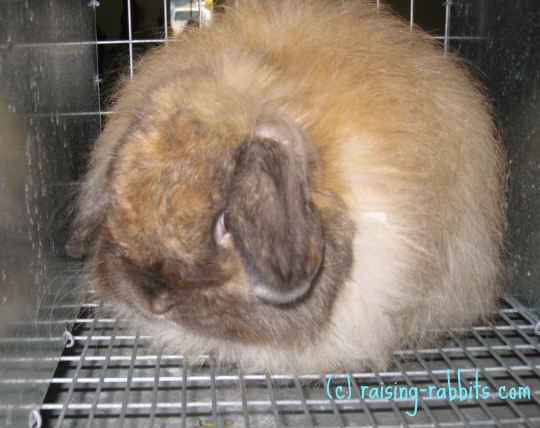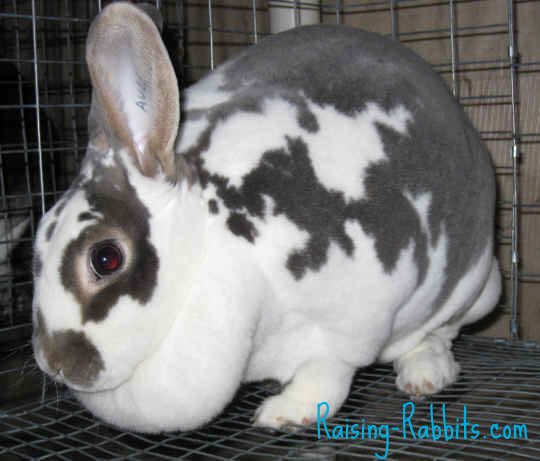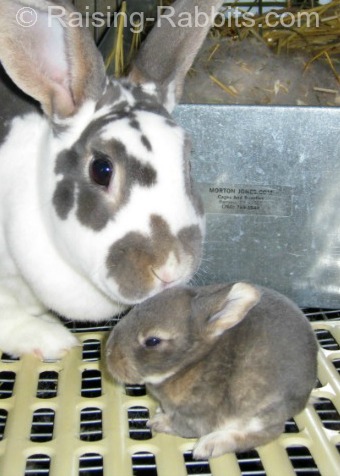Rabbit Rhythms
May 2020 Newsletter

Rabbit Rhythms May 2020:
Quarantine is hard, but things such as cute fuzzy bunnies can always make it better! Speaking of fuzzy, our featured breed this month is the American Fuzzy Lop. This adorable bunny is just the right mix of fluffy and cute! This breed is so unique in its breeding. Read about how it got the way it is.
Additionally, bunnies are popping out kits all over the place during this season. Knowing how to care for and feed a pregnant doe is essential for the health of newborn kits. We have a few tips for feeding your pregnant doe so that her kits get the most optimal start in life.
Plus, good nutrition additionally plays an important role in successfully raising your baby bunnies to weaning ages. We'll tell you a story about a rabbit owner who learned this the hard way.
Rabbits in the News: The Rabbit Hemorrhagic Disease is NOT gone! In fact, it just hit New Mexico, Arizona, and Texas, and will no doubt spread elsewhere. Learn the latest news on RVHD and what you can do to help prevent this disease from spreading to your precious bunnies.
Featured Breed: American Fuzzy Lop

Breed History rabbit rhythms may 2020
The American Fuzzy Lop was originally bred down from Holland Lops. Holland Lops used to come in only solid colors until breeders began to breed them with English Spots in order to introduce a broken pattern into their gene pool. The unintended result of this was their classic rollback fur was lost in the process.
Breeders began to breed the new Hollands with French Angoras in order to gain the lost trait back again. In addition to the rollback coat, the wool gene was also inherited. Holland Lops with the wool gene were reproduced in litters.
Patty Greene-Karle began breeding these new fuzzy Lops and showed them in 1985 to the Houston, Texas ARBA Convention. It later became an official breed in 1989.
Characteristics and Temperament
The American Fuzzy Lop certainly takes after its name as it is known for its soft, fuzzy coat and famous lop ears. It is dwarf-sized, has very rounded hindquarters and a broad chest. Their wool can be spun into yarn, but does not produce much because their surface area is smaller than that of an Angora.
Their coat is more coarse, minimizing the amount of matting and tangling. However, while grooming them, be sure to cover the tail area as this area may have more matting from sitting down. They come in a wide variety of colors and have a very playful, active, and affectionate personality. These characteristics make them great with kids, and an amazing family pet.
Feeding a Pregnant Doe
 This doe is heavily pregnant and about to deliver!
This doe is heavily pregnant and about to deliver!Taking care of a doe is one thing, but taking care of a pregnant doe is something else. A common question that arises is what do you feed a doe?
Tips for feeding a Pregnant doe: rabbit rhythms may 2020
- We recommend feeding your pregnant doe a commercial pellet, formulated with 16%-18% protein. You can even feed a 15% protein pellet, compensating for the lower protein by adding a teaspoon of whole oats or black oil sunflower seeds per day to her ration. (Any lower than 15% protein may not adequately support the doe's health or that of her unborn kits.)
- Increasing the quantity of her portion slowly, from day 14 up to her date of kindling. Once she has kindled, the doe can be free-fed.
- Avoiding high sugar foods and sweet fruits in the doe's diet as these can upset her digestive flora and create a potentially life-threatening diarrhea.
- Keeping on hand black oil sunflower seeds or whole oats. These can supplement the pregnant doe's rations, but they will be especially helpful for delivering an extra boost of fats after kindling in order to support excellent milk production. (Rabbit milk is very high in fats).
For more on how to care for a pregnant doe: Check out pages 150-162 in The Rabbit Raising Problem Solver.
Click here for options on feeding your pregnant doe with or without pellets.
Your Rabbit Health Questions Answered
Life and Death during the Springtime Rabbit Baby Boom: The Importance of Nutrition for Your Breeding Rabbits

Beth, from Florida, wrote to us about two of her 4-week-old bunnies that mysteriously died:
"Help!! Our doe had a litter of 6 babies on Easter Sunday. rabbit rhythms may 2020
"I had previously read all of your information on rabbit diarrhea so we kept mom and babies on only Timothy Hay with some organic greens. They have had no pellets or sweets. The first baby was found dead Sunday morning, at 4 weeks old. I had purchased benebac but not given it as there was no sign of illness. We gave benebac to mom and the 5 living babies on Sunday. Two days later another baby died. It was alive that morning.
"I gave a second round of benebac and have moved mom and babies indoors and using new water and food containers. We do keep the cages very clean and change the "litter boxes" every other day. My 4 little girls are so upset! What else can we do to prevent any more from dying? We live in Florida and it has just gotten hot, I did have a fan on the cage. There has been no signs of diarrhea that I can tell."
***** Karen Sez *****
Oh Beth, did our pages about diarrhea ever say don't feed pellets to a pregnant or lactating doe? Have you read anywhere on Raising-Rabbits that pellets are not good to feed? What the diarrhea page does say is that sweet, high carb treats, and a diet low in fiber can cause life-threatening problems.
Feeding only timothy hay and organic greens is basically a starvation ration for both your doe and her babies! There is not enough protein to sustain life over the long term in just grass hays with a bit of greens. I strongly advocate for feeding a balanced commercial pelleted ration to your rabbits, and for pregnant and lactating does adding a little bit of black oil sunflower seeds or whole oats to the daily feed to help the doe produce milk and feed the babies.
I hope you and your girls will try again to breed your rabbit, and this time, don't be afraid to feed your doe her pellets! Just provide a handful of hay every day and don't feed any sweet treats, and everything should work out great. Check our rabbit nutrition page. That should help you understand the basic nutritional needs of productive adult rabbits.
There are also many answers to be found in Rabbit Raising Problem Solver.
And yes, you can feed rabbits without pellets. This requires research in order to understand the nutritional needs of your rabbits, and then time and preparation in order to provide the necessary nutrition to your rabbits. The vast majority of us appreciate the convenience of a commercial pellet, but if you do your own research, you can very successfully feed an all-natural ration without pellets. Our e-book on feeding rabbits is a great place to start that research.
Next month, we'll discuss first-time rabbit moms, who have a frightful reputation of always losing their first litters.
Rabbits in the News: RVHD reaches New Mexico
Rabbit Hemorrhagic Disease is far from contained, and has just hit New Mexico. This disease is NOT transmittable to humans and NOT related to COVID-19. Wildlife managers in New Mexico reported recent deaths in both domestic and wild rabbit populations. This disease used to only be found in domestic and feral rabbits but recently made the jump to wild rabbits. Dead carcasses were picked up and tested positive for the virus. The New Mexico Fish and Game department request that any large, wild populations of rabbits should be reported.
Warning to commercial breeders!
This disease is highly contagious to rabbits and can wipe out your entire enterprise. Humans can also be vectors of transmission.
If you raise rabbits and live anywhere near an active outbreak of RHD (NM, TX, AZ, WA, for now), you will need to practice exquisite quarantine measures, and avoid contact with any dead rabbit carcasses if you suspect RVHD.
- Click here for more information on RVHD and what to do if you come into contact with it.
- Click here for more information on RVHD in New Mexico.
Fly Predators
Introducing Fly Predators: an all-natural, biological fly control solution that does not involve pesticides or poison!
What is a fly predator, and what do they do?
A fly predator is a small, nocturnal parasite that feeds on fly larva. They do not affect humans or animals and control the fly population with little to no effort! It takes about a month for the current fly population to die off, but once they do, you will notice a significant decrease in flies around your barn with no harm to you, or your animals!
Now is when rabbit breeders in the Northern Hemisphere should be introducing fly predators into our rabbitries. Click here for more information of fly predators!
Like this Rabbit Rhythms May 2020 Newsletter?
Maybe your friends would too...
- Forward this email to your friends!
- 'Like' us on any page of Raising-Rabbits.com
- Visit (and 'like' us) on Facebook as well...
https://www.facebook.com/RaisingRabbits
Your friends at Raising-Rabbits.com wish you a wonderful May 2020.
Enjoy your rabbits!
Double-Value Guarantee
Our policy is to always OVER-deliver
on value,
which is why your purchase is fully covered by our
Double-Value
Guarantee.
Go ahead - take any of our e-books for a test drive. Peruse our detailed informational and educational e-books. Examine our plans for building rabbit cages, runs, or metal or PVC hutch frames. Check out the Rabbit Husbandry info e-books.
If you aren't completely satisfied that your e-book purchase is worth at least double, triple or even quadruple the price you paid, just drop us a note within 45 days, and we'll refund you the entire cost. That's our Double-Value Guarantee.
Note: When you purchase your
e-books, they will be in PDF format, so you can download them to any device that
supports PDF format. We advise making a back-up copy to a drive or cloud
account. If the books are lost, you can also purchase another copy from Raising-Rabbits.










New! Comments
Have your say about what you just read! Leave me a comment in the box below.